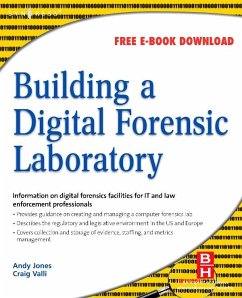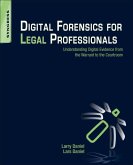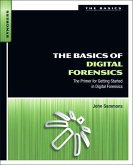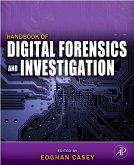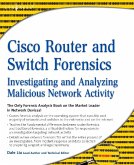Building a Digital Forensic Laboratory (eBook, ePUB)
Establishing and Managing a Successful Facility


Alle Infos zum eBook verschenken

Building a Digital Forensic Laboratory (eBook, ePUB)
Establishing and Managing a Successful Facility
- Format: ePub
- Merkliste
- Auf die Merkliste
- Bewerten Bewerten
- Teilen
- Produkt teilen
- Produkterinnerung
- Produkterinnerung

Hier können Sie sich einloggen

Bitte loggen Sie sich zunächst in Ihr Kundenkonto ein oder registrieren Sie sich bei bücher.de, um das eBook-Abo tolino select nutzen zu können.
The need to professionally and successfully conduct computer forensic investigations of incidents and crimes has never been greater. This has caused an increased requirement for information about the creation and management of computer forensic laboratories and the investigations themselves. This includes a great need for information on how to cost-effectively establish and manage a computer forensics laboratory. This book meets that need: a clearly written, non-technical book on the topic of computer forensics with emphasis on the establishment and management of a computer forensics…mehr
- Geräte: eReader
- ohne Kopierschutz
- eBook Hilfe
![Digital Forensics for Legal Professionals (eBook, ePUB) Digital Forensics for Legal Professionals (eBook, ePUB)]() Larry DanielDigital Forensics for Legal Professionals (eBook, ePUB)33,95 €
Larry DanielDigital Forensics for Legal Professionals (eBook, ePUB)33,95 €![The Basics of Digital Forensics (eBook, ePUB) The Basics of Digital Forensics (eBook, ePUB)]() John SammonsThe Basics of Digital Forensics (eBook, ePUB)14,95 €
John SammonsThe Basics of Digital Forensics (eBook, ePUB)14,95 €![Handbook of Digital Forensics and Investigation (eBook, ePUB) Handbook of Digital Forensics and Investigation (eBook, ePUB)]() Ma Casey BSHandbook of Digital Forensics and Investigation (eBook, ePUB)29,95 €
Ma Casey BSHandbook of Digital Forensics and Investigation (eBook, ePUB)29,95 €![Digital Forensics with Open Source Tools (eBook, ePUB) Digital Forensics with Open Source Tools (eBook, ePUB)]() Harlan CarveyDigital Forensics with Open Source Tools (eBook, ePUB)30,95 €
Harlan CarveyDigital Forensics with Open Source Tools (eBook, ePUB)30,95 €![Cisco Router and Switch Forensics (eBook, ePUB) Cisco Router and Switch Forensics (eBook, ePUB)]() Dale LiuCisco Router and Switch Forensics (eBook, ePUB)28,95 €
Dale LiuCisco Router and Switch Forensics (eBook, ePUB)28,95 €![Google Earth Forensics (eBook, ePUB) Google Earth Forensics (eBook, ePUB)]() Michael HarringtonGoogle Earth Forensics (eBook, ePUB)23,95 €
Michael HarringtonGoogle Earth Forensics (eBook, ePUB)23,95 €![Stealing the Network: The Complete Series Collector's Edition, Final Chapter, and DVD (eBook, ePUB) Stealing the Network: The Complete Series Collector's Edition, Final Chapter, and DVD (eBook, ePUB)]() Ryan RussellStealing the Network: The Complete Series Collector's Edition, Final Chapter, and DVD (eBook, ePUB)24,95 €
Ryan RussellStealing the Network: The Complete Series Collector's Edition, Final Chapter, and DVD (eBook, ePUB)24,95 €-
-
-
Dieser Download kann aus rechtlichen Gründen nur mit Rechnungsadresse in A, B, BG, CY, CZ, D, DK, EW, E, FIN, F, GR, HR, H, IRL, I, LT, L, LR, M, NL, PL, P, R, S, SLO, SK ausgeliefert werden.
- Produktdetails
- Verlag: Elsevier Science & Techn.
- Seitenzahl: 312
- Erscheinungstermin: 19. April 2011
- Englisch
- ISBN-13: 9780080949536
- Artikelnr.: 38125960
- Verlag: Elsevier Science & Techn.
- Seitenzahl: 312
- Erscheinungstermin: 19. April 2011
- Englisch
- ISBN-13: 9780080949536
- Artikelnr.: 38125960
- Herstellerkennzeichnung Die Herstellerinformationen sind derzeit nicht verfügbar.
This section provides a background to computer crime and addresses the Computer Forensics management issues related to Computer Forensic Incidents and Crime Investigations. It looks at how investigations are carried out, what needs to be considered in the planning of an investigation and the conduct of the investigation including the collection and storage of evidence. The section finishes with a number of case studies to highlight how things can go well if they are done properly and how they can go wrong if they are not.
Chapter 1. A Short History of Computer-Related Crimes and the Developing Need for Computer Forensics. This chapter will provide an overview of computer-related crimes from the less sophisticated and localized dial-up computer crimes to today's sophisticated, global, network attacks; as well as the history of the development of the computer forensics profession and increasingly formal computer forensics laboratories.
Chapter 2. An Introduction to Computer Forensics. This chapter provides an overview of the important concepts associated with "computer forensics." It describes the potential sources of evidence available in the typical microcomputer, how to conduct a search for evidence, and a method of conducting a search in a systematic and effective manner.
Chapter 3. Types of Forensic Investigation. This chapter will include the reasons for carrying out the investigation and the type of investigation that is being undertaken, for example single computer, network or mobile devices.
Chapter 4. Responding to Crimes requiring Computer Forensic Investigation. This chapter will talk about what actions are required, the management considerations and just as importantly, what should not be done when responding to a high tech crime scene. It will deal with the differing requirements that must be considered for the range of types of investigation that the laboratory may be called on to take part in including; stand alone PCs, Servers, Networks, Live Acquisition and wireless and will discuss the management issues that relate to the use of function specific tools.
Chapter 5. Management of the Collections of Evidence. As the title states, this chapter will talk about the management issues that relate to the collection of high technology crime scene evidence, a crucial part of any high technology investigation. It will also deal with issues such as continuity of evidence in of custody.
Chapter 6. Management of evidence storage. This chapter will address the issues that relate to the storage of evidence and the management issues that need to be considered to ensure that it is carried out effectively and to meet the relevant rules and legislation. We will also address the difficult question of long term storage periods, a particular problem for Law Enforcement.
Chapter 7. High Technology Crimes: Case Summaries. This chapter gives a range of cases that illustrate the types of incidents that may be encountered under the general grouping of high technology crimes. There are examples of cases that have been successful and other examples that highlight that a lack of good procedures can lead to considerable expense, loss of credibility and embarrassment. This chapter will also address the specific roles that the computer forensics laboratory and staff play in each of the cases cited.
SECTION II: Creating a Computer Forensics Laboratory.
This Section will provide a background explanation of Computer Forensics and address management issues related to the creation of a laboratory and a computer forensic investigations laboratory. The section will include an introduction to computer forensics and the types of investigation that may be encountered and will give advice on things that need to be considered when establishing a laboratory. The section will give ad
This section provides a background to computer crime and addresses the Computer Forensics management issues related to Computer Forensic Incidents and Crime Investigations. It looks at how investigations are carried out, what needs to be considered in the planning of an investigation and the conduct of the investigation including the collection and storage of evidence. The section finishes with a number of case studies to highlight how things can go well if they are done properly and how they can go wrong if they are not.
Chapter 1. A Short History of Computer-Related Crimes and the Developing Need for Computer Forensics. This chapter will provide an overview of computer-related crimes from the less sophisticated and localized dial-up computer crimes to today's sophisticated, global, network attacks; as well as the history of the development of the computer forensics profession and increasingly formal computer forensics laboratories.
Chapter 2. An Introduction to Computer Forensics. This chapter provides an overview of the important concepts associated with "computer forensics." It describes the potential sources of evidence available in the typical microcomputer, how to conduct a search for evidence, and a method of conducting a search in a systematic and effective manner.
Chapter 3. Types of Forensic Investigation. This chapter will include the reasons for carrying out the investigation and the type of investigation that is being undertaken, for example single computer, network or mobile devices.
Chapter 4. Responding to Crimes requiring Computer Forensic Investigation. This chapter will talk about what actions are required, the management considerations and just as importantly, what should not be done when responding to a high tech crime scene. It will deal with the differing requirements that must be considered for the range of types of investigation that the laboratory may be called on to take part in including; stand alone PCs, Servers, Networks, Live Acquisition and wireless and will discuss the management issues that relate to the use of function specific tools.
Chapter 5. Management of the Collections of Evidence. As the title states, this chapter will talk about the management issues that relate to the collection of high technology crime scene evidence, a crucial part of any high technology investigation. It will also deal with issues such as continuity of evidence in of custody.
Chapter 6. Management of evidence storage. This chapter will address the issues that relate to the storage of evidence and the management issues that need to be considered to ensure that it is carried out effectively and to meet the relevant rules and legislation. We will also address the difficult question of long term storage periods, a particular problem for Law Enforcement.
Chapter 7. High Technology Crimes: Case Summaries. This chapter gives a range of cases that illustrate the types of incidents that may be encountered under the general grouping of high technology crimes. There are examples of cases that have been successful and other examples that highlight that a lack of good procedures can lead to considerable expense, loss of credibility and embarrassment. This chapter will also address the specific roles that the computer forensics laboratory and staff play in each of the cases cited.
SECTION II: Creating a Computer Forensics Laboratory.
This Section will provide a background explanation of Computer Forensics and address management issues related to the creation of a laboratory and a computer forensic investigations laboratory. The section will include an introduction to computer forensics and the types of investigation that may be encountered and will give advice on things that need to be considered when establishing a laboratory. The section will give ad
